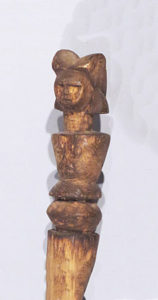Kwere
The Kwere people migrated to what is now Tanzania around 1000 A.D. from south of Mozambique. The Kwere do not have centralized political systems, but instead are based on self-governing matrilineal kin groups. Lineage heads are chosen by community leaders. These leaders are responsible for distributing land and maintaining lineage rituals. Leaders are also in charge of settling disputes between family members and are often attributed with having spiritual powers.
Most Kwere believe in mulungu (a supreme god), who was associated with rainfall. Most prayers are directed to familial spirits. Religion among the Kwere is a household affair and every family member is responsible for appeasing its ancestral spirits. Shrines were built to the spirits on the ancestral homeland and members of the family are expected to journey to these sites to make the proper offerings.
Kwere produce various wood sculptures, the best known is ‘mwana hiti,’ which translates to “wooden child” in Swahili. These Mwana Hiti dolls were carved for young girls upon reaching puberty to teach them maternal instincts.
Source: https://africa.uima.uiowa.edu/peoples/show/Kwere

